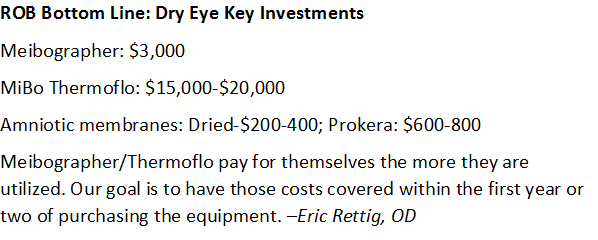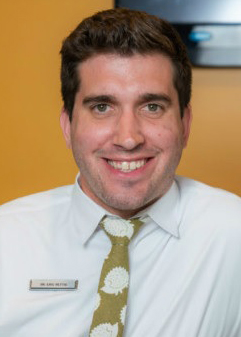By Eric Rettig, OD

June 19, 2019
Dry eye is an increasingly common condition, with the growing elderly population and ever-heavier use of digital devices. Here’s how my four-OD, 26-support staff practice has made diagnosing and serving these patients a revenue growth area.
We see 50-75 dry eye patients a week. That number has definitely grown in the past five years. A large part of this growth has been point-of-care testing that helps with diagnosis the day the patient is here, as well as the newer and more available treatment options we have. In addition, patients are much more aware of the disease now than they were five years ago, so they often ask about the symptoms of dry eye themselves.
Our practice generates over $250,000 annually from dry eye. This number has gone up each year over the past five years, and we expect that number to continue to grow. Revenues per patient visit generate anywhere from $120 to $400 depending on the services provided.
 Start Small & Grow Services
Start Small & Grow Services
We started with offering tear osmolarity testing with TearLab and then added Inflammadry. We’ve also purchased a meibographer to help assess the meibomian glands. The images are great for patient education. Last year we added the MiBo Thermoflo to our practice, which so far patients have responded well to.
In our area, in upstate Pennsylvania, this instrument made the most sense financially, as we wanted to be able to keep these treatments affordable to nearly everyone, while also not being a huge financial burden for us. The doctors in our practice and our patients are liking the results. We also do a lot of punctal occlusion in our practice, which is great for patients who have difficulty with compliance for artificial tears or other medications that treat poor tear production.
In addition, we use amniotic membranes to treat some severely dry patients. These are patients who often have systemic issues causing their dry eye to worsen and have trouble getting relief from other therapies. Amnion helps to rejuvenate the ocular surface and kick-start healing. Amniotic membranes aren’t used all the time, but they are a great tool for difficult cases, as well as another revenue stream.
Set Aside Needed Chair Time
Needed time for patients varies, but for most cases, there isn’t a lot of chair time needed. This is something I like about managing dry eye. Patients can be seen at any time of day, and even between comprehensive examinations. I spend a few minutes discussing the patient’s symptoms and concerns and then I examine their eyes and analyze data obtained during pre-testing (our staff is trained to get a TearLab and Inflammadry on every dry eye patient).
Other Articles to Explore
I discuss treatment options with the patient and what I feel will work best for them, and then prescribe a treatment. This takes no more than 10 minutes total for me, and any other tasks are handled by my staff. The doctors do not need to perform the MiBoThermoflo, and don’t even need to be in the office when the patient comes in for their treatment. Our patients receive a series of four treatments over a six-to-eight week period and then are scheduled for a follow-up visit with the doctor.
We don’t have specific days or time slots devoted only to seeing dry-eye patients, but we do have specific scheduling times for MiBo Thermoflo treatments. We set aside a few times each week during which patients can come in to have those treatments done. We do this because the treatments can take between 20-30 minutes, and we also want to make sure we have a room available for the treatments.
Provided Needed Support-Staff Training
We train our staff to gather information and take a good history, which is vital to finding dry-eye patients. They will also perform point-of-care testing based on patients’ chief complaints and at follow-up appointments. Many of our staff members are trained in how to perform a MiBo Thermoflo on a patient, and we have a dedicated staff member for those treatments.
Educate Patients
Education is definitely necessary for patients, as many don’t realize the symptoms they describe are related to dry eye. I always try to explain things to them using an example from their life that they would be familiar with.
For instance, for something as simple as using artificial tears regularly, I use the example of changing your oil in your car. You don’t change your oil when you start to have problems, you do it regularly to avoid problems; same goes for artificial tears. If you only use them when your eyes feel dry, then there is always going to be a point that they feel dry, but if you get in the habit of using them on a regular basis, you can avoid having those symptoms.
Another example is explaining how punctal plugs work. I use the analogy of the lacrimal system as a sink and faucet. The lacrimal gland is like a faucet and the puncta/lacrimal system is the drain. We use plugs to slow down the drainage of tears.
Play Videos About Dry Eye in Your Reception Area
We do internal marketing of our dry-eye services in our office on TVs we have displayed in the reception areas. The segments we play provide information about new treatments we have to offer. They also help “plant the seed” of dry-eye knowledge in patients who may not have considered it a possible cause of their visual symptoms, encouraging them to ask the doctor about it.
 Eric Rettig, OD, is a partner with Mountain View Eye in Altoona, Penn. To contact him: ericmrettig@gmail.com
Eric Rettig, OD, is a partner with Mountain View Eye in Altoona, Penn. To contact him: ericmrettig@gmail.com





















